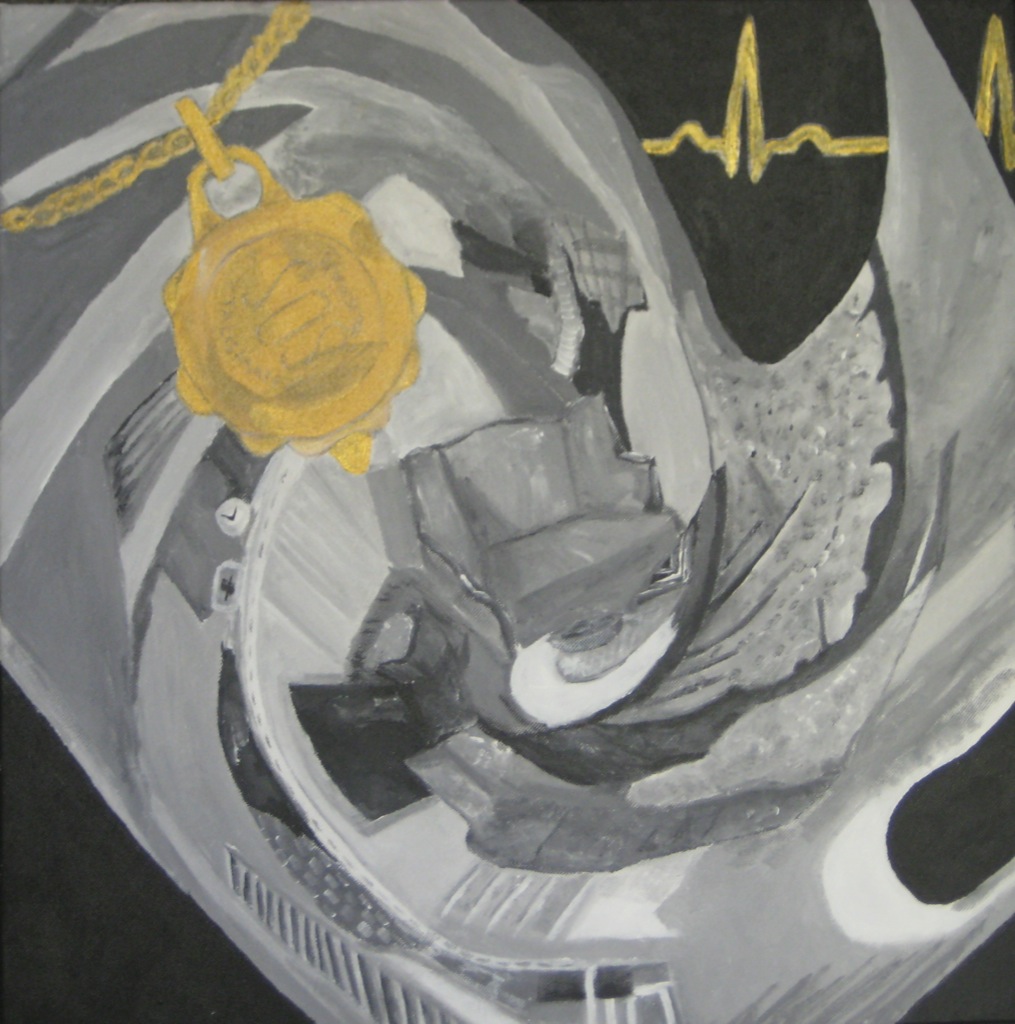Vertigo
I have therefore tried to portray this in my piece by digitally distorting a photograph of a living room before translating it to canvas using acrylics.
The disease was treated but has since returned with new symptoms, the patient herself is unsure whether it is the same thing. The new symptoms include blackouts and she cannot look up or down without feeling light – headed. She also cannot sleep, especially on her left-side, as her head feels empty and she is constantly anxious that she will pass out – something which is exacerbated by the fact she lives alone.
Living with this disease has also proved to be very dangerous as at any moment she could lose consciousness and she has endured many frightening and distressing episodes both alone and outdoors.
For reassurance purposes she wears a gold plated talisman S.O.S. necklace, which she was kind enough to show us. Inside is a list of all her next of kin details and relevant medical information; such as her blood group and that she wishes to donate her organs. I have chosen to construct the painting itself in black and white to reflect the despair of living with the illness and the necklace is in gold to reflect the small amount of security she feels by wearing it.
Some years ago she was suffering from a separate complaint, which also affected the way that she lived; her arms and legs kept sporadically going limp. This was hard to diagnose as the limpness never occurred while she was with in a clinical situation. However, the condition was totally debilitating, as she felt unable to do simple tasks such as painting the fence (this is what she was doing when it first happened), or hold her grand-children. It was not until two years later that it happened in front of a doctor. She was immediately referred and had a pacemaker fitted the next day. I have painted an E.C.G. trace to show this aspect of the illness. The cause was unknown but it was thought that her heart had been scarred from early childhood illnesses.
In conclusion, both of these illnesses severely impacted on the lady’s day-to-day living. They were not only frustrating, but also terrifying at the same time. It was really good to see how she had coped with her illnesses and how different members of the medical profession had helped her. She actually managed to relax during her operation, which she was awake for, the surgeon played her choice of music, and she was able to chat with the nurses while it was going on.
This experience has reinforced how important it is to listen carefully to the patient and to trust them. On asking what the most important quality of a doctor was, this was her only opinion. She also stated “I know my own body better than any doctor,” which although is obviously true, I had never heard it put in that way before and hearing it from a patient emphasised the point further.
* details changed to maintain patient-confidentiality
I really enjoyed the creative process; it helped me express what she was experiencing in a more fluid, visual and emotional way as opposed to just writing down symptoms. I think it is important for medical students to develop their creative skills in order to become well-rounded individuals.

I really like this painting, and I think it is a really interesting portrayal of a patient’s medical story. It depicts how the patient sees the world differently from most people, and gives a good insight of how difficult this is for them. It is particularly striking that the scene of a living room has been used, since this is a safe and relaxing place for most people, and shows how this patient’s condition is affecting aspects of her life which most of us would take for granted. I also think it adds to the painting that the sides of the image don’t span across the whole canvas, and the black edges may represent the parts of life the patient is missing out on, like holding her grandchildren. This piece has made me think more about what it is like to live with vertigo, and the difficulties that this brings.